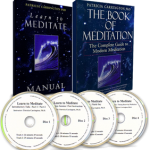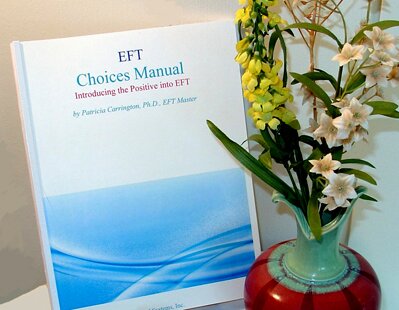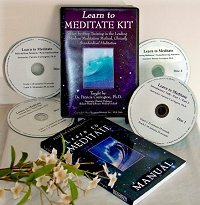10 Ways to Combine Meditation with EFT
by , PhD
While there may be other reasons for the success I have obtained in combining EFT tapping and modern meditation, here is what I have observed over the more than 25 years that I have been experimenting with using these two techniques for my clients and groups.
Meditation provides a constant stabilizing effect that supports the periodic troubleshooting action of EFT/Tapping. Meditation brings a special type of enforced rest each day to the person who uses it — one that is easier for the average person to observe than are vague therapeutic prescriptions to "take it easy and get more rest," and it is quite different in its effects from just napping. It therefore has a special value for many people. I find that “meditative rest” gives a more solid basis to my EFT work with clients. After commencing meditation, people tend to become steadier emotionally and better able to handle any difficult problems that may arise during their EFT sessions. They are also more apt to bring up core problems to deal with during EFT, ones they might have felt unprepared to tackle before.
Meditation Reduces Anxiety Markedly. Although we frequently see EFT reduce anxiety dramatically, I find

|
that it is only the person who consistently uses EFT every day to target their anxieties who, in the long run, becomes less prone to unreasonable fears in general ( i.e. who overcomes generalized anxiety). Unfortunately not too many people have the persistence needed to chip away at overwhelming anxiety using a targeted technique such as EFT, and it is very valuable to help such people get a running start on their anxiety-reduction by using a global technique such as meditation to reduce their overall level of anxiety. Since meditation does not target a specific problem the way EFT does, it allows the entire body, mind and spirit to find a peaceful space to be in so that EFT can do its work.
If a client’s anxiety level is too high to sustain the gains we have made with EFT for a long enough time to allow them to “take hold”, I usually teach that person Clinically Standardized Meditation (CSM) and we often see the benefits of doing this within the first week. At that point, the regular practice of meditation can turn the tide in my EFT work with that person. It can change the client who is too distressed to know which issue to tackle first, into a calmer and more focused person. When that happens, I then have someone “to work with” in our therapy sessions instead of having to rescue my client repeatedly from a state of deep anxiety. Regular meditation can therefore be a great help in sustaining the benefits of EFT.
For Physical Illness. Another area where I find the use of meditation combined with EFT to be extremely valuable is for stress-related illness. We have learned a great deal about the possibilities of using EFT in this area and the advantages of adding meditation to the therapeutic “mix” for this purpose are impressive.
Research shows that many stress-related illnesses respond extremely well to meditation. These range from bronchial asthma to high blood pressure, to heart conditions, to high cholesterol, and to many of the addictions, to name but a few. Treating a physical condition with EFT and meditation (a winning combination in my estimation), the person gets help from two different directions at once; EFT targets the core issues that need to be dealt with, and meditation lends both physiological balance and spiritual support to this process.
Sleep Problems May Need the Combination of Both Techniques. Sleep problems have been shown by research and clinical reports to be so responsive to meditation that if I have to decide whether to use meditation or EFT to start with for this condition, I usually choose meditation as the first line of attack because of its remarkable physiological relaxing effect. Research has shown that meditation has an excellent ability to counteract insomnia and my clinical experience strongly confirms this. However, eventually I tend to use both methods combined for this purpose. Meditation gives the person a quieter and deeper sleep, often quite soon after they learn it, and EFT can then target specific bouts of wakefulness and deal with the deeper problems in the person’s life that may be causing the insomnia in the first place. Again, a winning combination.

|
Meditation’s Energy Increase Can Assist EFT. For many people, meditation results in a surge of deeply nourishing energy which, if they meditate daily, becomes part of their life from that point on. This results in a lessened need for daytime naps, increased physical stamina, increased productivity, the dissolving of writers or artists’ block, and sometimes the release of unsuspected creative potential. I find that as we work on specific blocks to creativity using EFT, adding meditation to the client’s life can be extremely useful to open up their creativity in general. It can assist targeted EFT sessions by working continuously night and day to dissolve the underlying block. Again, the two methods can work synergistically to achieve remarkable results.
Lessening of Self-Blame. A little-known effect of meditation is the lessening of inappropriate self blame often reported by meditators. This can result in an impressive change from self castigating to self accepting, self nourishing behavior. While we can tackle the specifics of a client’s self-image problems with EFT, the addition of meditation –– a time when the person is in close communion with a deeper part of themselves that is totally nonjudgmental – can assist profoundly. I often watch with wonder as a person becomes less self-critical after they take up meditation and often develops a simultaneous increase in tolerance for the human frailties of others. This makes it easier for them to tackle more sensitive issues with EFT because self-blame is no longer getting in the way of their doing so. Meditation can therefore be of great assistance to EFT when a tendency toward self blame is excessive–– one technique complements the other.
Meditation Makes Previously Buried Emotions More Accessible
Another way that mediation can help progress with EFT stems from the fact that those who commence meditation often find hidden emotions coming to the surface. Meditators often report experiencing pleasure, sadness, anger, love, and other emotions more fully than they did before and sometimes they experience emotions which had previously been unavailable to them, or recover buried memories that are emotionally charged. These memories or emotions can then be worked on productively with EFT.
Increased Sense Of Identity
People who meditate regularly often report that they have become more aware of their own opinions after commencing meditation, that they are not as easily influenced by others as they were before, and that they can arrive at decisions more quickly and easily. They may also be able to sense their own needs more accurately, and therefore become more outspoken and self assertive and more able to stand up for their own rights effectively. This natural flowering of a sense of self and of one’s own genuine rights works to assist EFT by allowing the person to tackle self-assertion and self-esteem issues much more quickly with EFT than they might otherwise do.
I find that in their EFT sessions, the person now tends to bring up core issues more readily and to have more courage dealing with them than they did before. They may also be more willing to address issues of self assertion with EFT where before they may have felt that this would be futile.
Ability to Separate From Others Where Necessary
One result of the increased sense of identity that comes with meditation is the person’s ability to separate from significant others when such a separation is called for. Meditation can be dramatically effective for counteracting pathological bereavement reactions, impending separation or divorce, the anticipated loss of children who are growing up and will soon leave home, etc. EFT can then be used to zero-in on specific painful thoughts associated with the impending (or actual) loss, and change them to positive and appreciative thoughts. The soothing effects of meditation can be an enormous help as it works in the background and we apply EFT in the foreground.
Marked Lowered of Irritability
Many meditating people become far less critical in their personal relationships within a relatively short time after commencing meditation. A large-scale study of CSM meditation at the New York telephone company, in which over 5,000 employees were taught this method, showed that a marked lessening of irritability and shortness of temper" was one of the most appreciated results of meditation.
I find it extremely useful to add meditation to a client’s EFT treatment if impulsive outbursts or chronic irritability are an important part of the picture. It is extremely useful to obtain the general lowering of irritability that comes with meditation so that we can move more easily from issue to issue with EFT.
Conclusions
To sum up the use of meditation together with EFT, we might say that this combination allows the person to approach any problem from two different angles at once –– the global approach of meditation melding with the specific approach of EFT, each technique augmenting the other. And, as the old saying goes,” The whole is (often) more than the sum of its parts.”
Dr. Patricia Carrington, EFT Master,
——————————————————————————————————–
For more information on learning meditation, visit our Meditation Center



